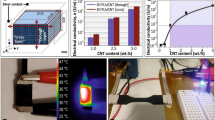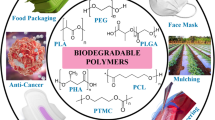Abstract
This paper addresses the modification of epoxy-amine systems with new reactive compounds, oligohexamethyleneguanidine salts. Using commercial hydrochloride of oligohexamethyleneguanidine, its hydrosalicylate, hydro-5-sulfosalicylate, and hydro-4-aminosalicylate are isolated and characterized. During salt preparation, the main macromolecular chain of oligohexamethyleneguanidine remains almost intact. The scheme advanced for the covalent introduction of a modifier in an epoxy-amine network involves the preliminary synthesis of the adduct of an epoxy oligomer and oligohexamethyleneguanidine salt followed by its cure with oligoamine. Conditions for formation of uncured viscous-flow adducts well miscible with the epoxy oligomer and the curing agent are determined. Using these adducts, the cured elastic films are obtained, among which samples modified with oligohexamethylene-guanidine hydro-4-aminosalicylate demonstrate the most pronounced activity against model microorganisms Mycobacterium smegmatis. These materials show promise as a basis for the development of biocidal coatings.







Similar content being viewed by others
REFERENCES
Epoxy Polymers. New Materials and Innovations, Ed. by J.-P. Pascault and R. J. J. Williams (Wiley-VCH, Weinheim, 2010).
E. M. Petrie, Epoxy Adhesive Formulations (McGraw-Hill, New York, 2006).
J. K. Fink, Reactive Polymers – Fundamentals and Applications (William Andrew Publ., Norwich, 2005), p. 139.
V. G. Khozin, Reinforcement of Epoxy Polymers (Dom pechati, Kazan, 2004) [in Russian].
Yu. S. Zaitsev, Yu. S. Kochergin, M. K. Pakter, and R. V. Kucher, Epoxy Oligomers and Adhesive Compositions (Naukova dumka, Kiev, 1990) [in Russian].
I. N. Senchikhin, E. S. Zhavoronok, A. V. Matveev, O. Ya. Uryupina, and V. I. Roldughin, Colloid J. 80, 324 (2018).
E. S. Zhavoronok, I. P. Sedishev, A. V. Safonov, and I. N. Senchikhin, Polym. Sci., Ser. A 61, 610 (2019).
S. A. Kedik, O. A. Bocharova, Kha Kam An, A. V. Panov, I. P. Sedishev, E. S. Zhavoronok, G. I. Timofeeva, V. V. Suslov, and S. G. Beksaev, Pharm. Chem. J. 44, 568 (2010).
E. G. Salina, Candidate’s Dissertation in Biology (Inst. Biokhim. im. A.N. Bakha, Moscow, 2006).
N. Casali, V. Nikolayevskyy, Ya. Balabanova, S. R. Harris, O. Ignatyeva, I. Kontsevaya, Ju. Corander, J. Bryant, Ju. Parkhill, S. Nejentsev, R. D. Horstmann, T. Brown, and F. Drobniewski, Nat. Genet. 46, 279 (2014).
“Mycobacteria,” in European Pharmacopeia in Russian (Gruppa remedium, Moscow, 2015), Vol. 1 [in Russian].
S. A. Kedik, D. O. Shatalov, P. M. Isaykina, A. D. Askretkov, I. P. Sedishev, A. V. Panov, and A. S. Evseeva, Pharm. Chem. J. 51, 773 (2017).
S. G. Entelis, V. V. Evreinov, and A. I. Kuzaev, Reactive Oligomers (Khimiya, Moscow, 1985) [in Russian].
F. G. Garcia, P. M. Silva, B. G. Soares, and J. R. Briones, Polym. Test. 26, 95 (2007).
Zh. Sun, J. Zhang, X. Zhang, S. Wang, Y. Zhang, and Ch. Li, Int. J. Antimicrob. Agents 31, 115 (2008).
A. K. Ivanov, Tuberculosis. Features of Progress, Possibilities of Pharmacotherapy (St. Peterburgskaya Gos. Med. Akad. im. I. I. Mechnikova, St. Petersburg, 2009) [in Russian].
S. E. Borisov and G. B. Sokolova, Consilium Medicum 3, 595 (2001).
ACKNOWLEDGMENTS
We are grateful to E.K. Urodkova (Frumkin Institute of Physical Chemistry and Electrochemistry, Russian Academy of Sciences) for her help in registering FTIR spectra. The experiments were carried out using equipment of the Shared Research Center of the Frumkin Institute of Physical Chemistry and Electrochemistry, Russian Academy of Sciences.
Funding
This study was supported by the Ministry of Science and Higher Education of the Russian Federation. We are also grateful to the Russian Foundation for Basic Research (project no. 18-08- 01252А) for financial support.
Author information
Authors and Affiliations
Corresponding author
Additional information
Translated by T. Soboleva
Rights and permissions
About this article
Cite this article
Zhavoronok, E.S., Sedishev, I.P., Merkulova, M.S. et al. Covalent Modification of Epoxy-Amine Systems with a Guanidine-Containing Oligomer to Enhance Their Activity against Pathogenic Microorganisms. Polym. Sci. Ser. B 63, 31–40 (2021). https://doi.org/10.1134/S1560090420060135
Received:
Revised:
Accepted:
Published:
Issue Date:
DOI: https://doi.org/10.1134/S1560090420060135




